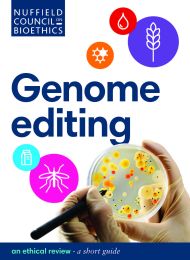Genome editing: an ethical review
Report
Published 30/09/2016

Genome editing in brief: what, why and how?
What do we mean by ‘genome editing’?
Almost all cells of any living organism (e.g. a human, animal, plant, bacterium) contain DNA, a type of molecule that is passed from one generation to the next during reproduction. DNA is involved in many essential biological processes including building cells and controlling their number and type, the production of energy, the regulation of metabolism, and fighting disease.
The term ‘genome’ generally refers to the entire sequence of DNA of an organism. The genome includes genes: sequences of DNA with specific functions that are involved in the production of the proteins needed to carry out many biological roles. It also includes regions of DNA that promote or inhibit gene activity, and regions that do not appear to affect protein production or function.
Gene expression
This short animation from Genome Research Limited shows how proteins are made in the cell from the information in the DNA code.
WATCH THE VIDEO
Genome editing is the deliberate alteration of a selected DNA sequence in a living cell. A strand of DNA is cut at a specific point and naturally existing cellular repair mechanisms, then fix the broken DNA strands. The way they are repaired can affect gene function and new DNA sequences can be delivered when the DNA is cut and act as templates for generating an altered sequence. Genome editing techniques can be used to delete sections of DNA or alter how a gene functions: for example, by changing a variant that may give rise to disease to one that functions normally.
How does it work?
Genome editing techniques make use of certain proteins that can cut DNA in a precise, targeted location. Although this family of proteins was discovered in the 1960s, it is only since around 2005 that the ability of some of them to make precisely targeted cuts at almost any position in the genome has been recognised and utilised by scientists.
Among the recent genome editing technologies, CRISPR-based methods are particularly promising owing to their relative efficiency, low cost; and ease of use, and the prospect of making edits at multiple sites in the genome in a single procedure.
What is CRISPR-Cas9?
CRISPR-Cas9 is a widely used genome editing method. It has two components. CRISPR stands for ‘clustered regularly interspaced short palindromic repeats’. This refers to the basis of the ‘guide system’ that finds the ‘target’ – the specific sequence of the DNA that is to be modified. Cas9 stands for ‘CRISPR-associated protein 9’, the protein that cuts the DNA at the target site. CRISPR-Cas9 systems that target specific sequences can be produced relatively easily in a laboratory, or obtained in the form of commercially available kits that can be purchased online.
WATCH A VIDEO FROM THE INNOVATIVE GENOMICS INITIATIVE
What is genome editing used for?
Most uses of genome editing have so far been in scientific research – for example to investigate models of human disease. However, the potential applications of these techniques are much wider than just research. Given that genome editing has the potential to alter any DNA sequence, whether in a bacterium, plant, animal or human being, it has an almost limitless range of possible applications in living things.
Areas of research and possible applications include:
- Crops and livestock (e.g. increasing yield, introducing resistance to disease and pests, tolerance of different environmental conditions)
- Industrial biotechnology (e.g. developing ‘third generation’ biofuels and producing chemicals, materials and pharmaceuticals)
- Biomedicine (e.g. pharmaceutical development, xenotransplantation, gene and cell-based therapies, control of insect-borne diseases)
- Reproduction (e.g. preventing the inheritance of a disease trait)
We expand on these areas in relevant sections of the review.

Share